
One of the Dahlias at Volunteer Park
We were in Seattle on our way to hike around Mt. Rainier and on a morning stroll from our B&B we encountered the very lovely Volunteer Park Dahlia Garden at the peak of its bloom. This was a great way to see many Dahlias side by side all covered with the morning dew. This wonderful little garden is maintained by the Puget Sound Dahlia Association and it’s well worth a visit if you are in the area.

Sign at Volunteer Park, Seattle

Volunteer Park Dahlia Garden

Dahlias at Volunteer Park

Dahlia 'Crazy Legs'

Dahlia 'Hamari'

Dahlia 'Tomo'

Dahlia 'Neon Splendor'
Wrapping up the Harvest

Freezing Tomatoes
We are about to take off to hiking in the Northwest for a week and so we’re gathering in some more of the harvest before we go. The soups, sauces, and tomato supper dishes were not keeping up with the influx so we’ve taken to freezing the tomatoes. Much like we do with blueberries, the tomatoes are simply cored and spread on a cookie sheet to freeze and then we take those rock solid red tennis balls and put them in plastic bags. Then at some point we will add those tomatoes to tomato-based sauces this winter.
One of the fruits reaching the harvest point right now are the Japanese Pears.

Japanese Pears fully ripe
This a tree we often call Josh’s miracle tree for the spectacular recovery it made from a near death experience. The full story will be told at a later date… Suffice it to say for now that this is a consistent yielder of fully organic, no-need-to-spray fruit. The flavor will never match a good Doyenné du Comice Pear, but you can’t have everything…

The Japanese Pear is a prolific bearer every year
I should have mentioned earlier that the early mums that we get every year are doing their thing and have been out for at least a month. Don’t know why they come so early but we won’t complain.
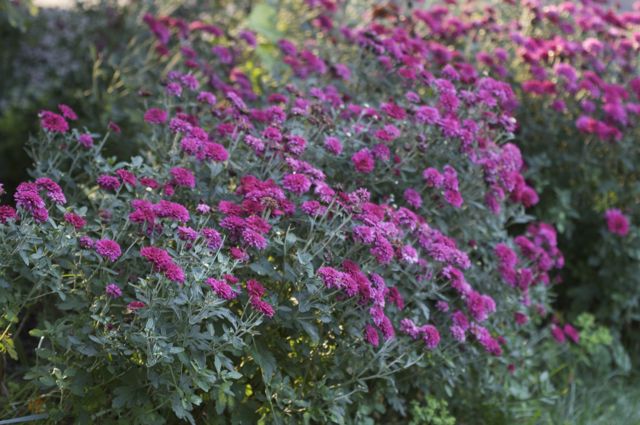
Early blooming Chrysanthemum
This is a good time of the year for butterflies and dragonflies. I noticed one odd looking dragonfly the other day and I now realize that it’s quite common. In fact it’s known as the ‘Common Whitetail’. Nonetheless it is quite distinctive to look at.
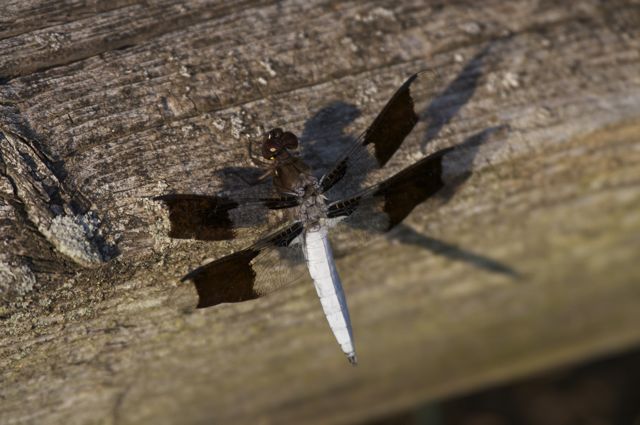
Common Whitetail (Libellula lydia)
We’ve just had two days of rainfall (finally!) but I went out one of the hot dry days before that and dug a new Iris bed.

Tilling a new Iris bed
I really went for overkill but who knows what else can go in this sunny spot before we get enough Iris to fill it. At the moment we only have an additional 9 Iris from Schreiners and several from our Boston connection but once I was into digging I had to complete the row. It was very dry but I persisted with the plow attachment on the roto-tiller and then filled the trench with water and repeated the process. I think I could have used the sweat from my drenched tee-shirt to soften the ground as well. I followed by filling the new trench with compost and then doing it all over again. Even with all of that it would probably be good to let the remainder lie fallow and do it again next year but we shall have to see what else needs planting in the interim…
On the bird front we had a cute little visitor the other morning. My guess is a Yellow-Throated Vireo but I’m open to other interpretations.

Yellow-Throated Vireo? (Vireo flavifrons)
And let me close this post with another image of the Northern Sea Oats. The world can simply not have enough of these beautiful plants which look different in every kind of light.

Northern Sea Oats (Chasmanthium latifolium)
A Tomato Fest

The daily picking baskets
I saw a reference to Summer Fest on A Way to Garden and since this was the Tomato week for that celebration I thought it would be good to talk about the tomato harvest here.
Last week we saw the movie Julie & Julia (Great flick!). It certainly sets a high standard for appreciation of food and it’s preparation (though I probably saw more butter than I’ve eaten in my lifetime). We have currently been relishing our own incoming produce and the many minor variations of cooking everything that’s being harvested. It’s mostly tomatoes, peppers, squash, cucumbers, beans, onions, and eggplant. The evening meal is some variation of tomatoes, peppers, squash, onions and eggplant stir fried together in olive oil and balsamic vinegar with garlic and herbs to taste (Beth uses fresh stuff from her herb garden and I tend to grab the dried products off the shelf). For protein we throw in some tofu or chicken meatballs and a little mozzarella cheese. If I’m the one doing the mixing some kind of nuts will be involved (pine nuts, hazelnuts, or walnuts). Every night is slightly different but always delicious. The ritual ends with us lifting the plate to our lips and draining the plate of the last of the luscious tomato-based sauce. Altogether with cutting up this takes two people maybe 15 minutes to prepare and could not be much better.
However, even with this kind of eating we’re not even close to using the produce. Beth cooked up a couple of batches of tomato sauce for the winter this week. This gives her more opportunity to tap into her herb garden. And we’ve been giving stuff away as well. And yet, the refrigerator overfloweth. I feel bad for the folks in the northeast who’ve been hit by blight. We were fortunate that everything was grown from seed and we have had sort of a mixed bag of rainfall — good rain early on and a lot of dry sunny days in July/August — which has had me doing hand watering but it’s been good for the tomatoes and peppers. I don’t think we’ve ever had peppers this nice.

Some big blocky red peppers

Tomatoes are slowing down but many still on the vines
The hot weather has made it less desirable to work in the garden and it is starting to get away from me. But I also know that we are going hiking in the west in a few days so that there is only so much I can do anyway.

Garden is getting overgrown
Strawberry Fields Forever…
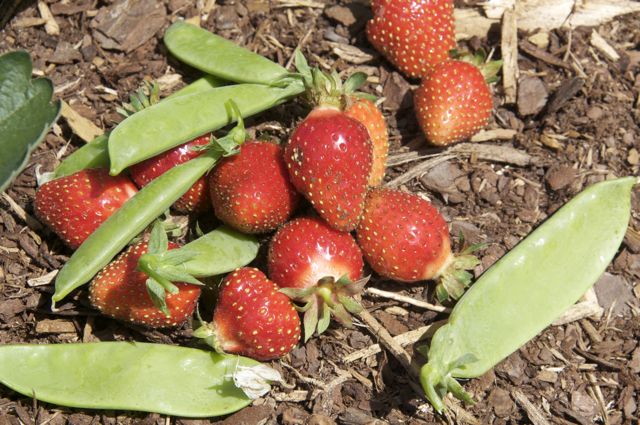
Strawberries and Peas
This year I took a good look at the old strawberry row replete with weeds that were very well established. I decided it was time to start a new row. This had two major positives right off the bat. It meant I didn’t have to weed the old row and the weeds would definitely have a slower start on the new row. On the other hand it’s a fair amount of labor to put in a new row if you do it well. So I compromised by putting in a partial row on the theory that even unweeded the old row was going to yield some berries.
I usually plant a double row with 1 foot spacing so even a partial row is 75 plants to be planted by my extensive labor force (me). The ground has to be well-tilled so it has all the usual problems of trying to get plants in the ground around the April rainstorms. I finally got them in about mid-April. And then added pine bark mulch to try to suppress the weeds for a while. I’ve used straw in the past but it’s tough to find bales with no grass seeds.
As it turns out we did get a fair amount of strawberries from the old plants and now the new plants are beginning to yield.
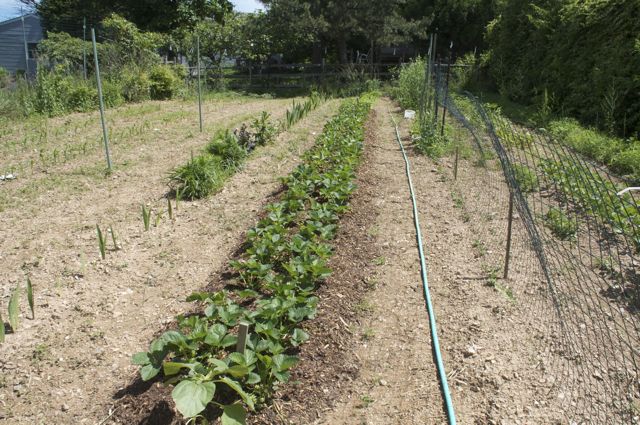
The New Strawberry Row
Now a better man than I would have pinched off the blossoms so that the plants could go stronger for next year but I confess to limits in my ability to delay gratification.

Earliglow Strawberries
The varieties I put in are not particularly special (Earliglow, Allstar, and Sparkle) but hey anything you plant in your home garden is so much better than what you find in the supermarket. And there is nothing quite like picking a hot strawberry and eating it in the garden.
Another daily yield right now is coming from the salad crops. The combination of actually weeding them and the regular rainfall has given us some of the best greens we’ve had in a while.

Salad Crops in Early June
And with peas and asparagus there has been ample reward to going out to the garden every day… 🙂
Just In Time Planting
As of yesterday we were getting a bit impatient with the progress on the vegetable garden. The steady rains have been great for the perennial gardens but I still hadn’t gotten many of the vegetables planted. And several days of sunshine had helped but when I tried tilling on Saturday it was still too wet. When we woke up the weather had changed and was showing another rainstorm in the offing. I went out first thing to the garden and gave the ground another once over with the tiller. This time the soil was right — just crumbling in the hand as I squeezed it. So I ran the tiller plow down the rows and then tilled once more for most of it. I also removed one of the local inhabitants to protect him from the tiller.

Eastern Box Turtle (Terrapene carolina)
Then I broke out the seeds and plants. The snap peas had failed miserably compared to the standard snow peas, so I replanted them in part of the space and then added pole beans as well. The sunflowers went in for general flower picking and to participate in the Great Sunflower Project. For the main flower picking row I put in zinnias, marigolds, cosmos, cleomes, stocks, and a host of wildflower seeds from Wildseeds. May the best flower win!
Then I put in 3 kinds of squash, pumpkins, and 2 kinds of cucumbers. Finally I got to the seedling plants that had been hardened off on the porch. There were 18 tomatoes (mostly Jetstar and Supersonic with Primetime, Juliet, and Grape thrown in), 16 peppers (Declamation, Boynton, Big Bertha, Yellow Pimento, Red Pimento, and Carmen), and 9 Eggplants (Hansel, Gretel, Fairytale, Little Fingers, and Classic). Curiously, although the eggplants have been sitting on the back deck for nearly 2 weeks, no sooner did I put them in the garden than they were immediately attacked by flea beetles. The latter have become a major pest for eggplant. They devastate the leaves which look like they have been hit by a shotgun. I thought it was amazing that the limit their range to the garden and not to the yard. We may try growing some in pots. As I did the final planting (the corn will have to wait for another day) the raindrops started in by about 1pm.

The newly planted vegetable garden as seen today
And by 4pm we had a drenching rain. I was really glad that the timing worked out to get such a fine start for the seeds.
How One Thing Leads to Another…

Northern Sea Oats (Chasmanthium latifolium) photo by Jonathan Willis
This episode goes back to a visit to Boston last year when I saw Northern Sea Oats growing for the first time. The bronzed seed heads were lovely and all the steps along the way were attractive too. I added it to our order list from Bluestone in January and got three lovely plants that were especially large for 1 Qt containers. In the meantime we began reading about how, as pretty as they are, they can be somewhat invasive for many people. Armitage in his Native Plants says that this is one plant that wears its invasiveness with pride. So we decided to be a little cautious and not put this, as originally intended , in the rock garden. But then, the question was where to put them with a full sun opportunity to shine.
And so the need for another garden space arose. We have a sunny bank where the Walnut Tree used to be (yes, I know the walnut roots may still be in the soil but I’m not one to be stopped by details), and even more specifically there is a bare place that used to be a Red Pine. Time for the Kubota Tractor.

Using the post-hole digger to start a garden bed
The post-hole digger finds out real quick where we can go deep enough for a garden and where not. Most of this area, except for one rock shelf, we were able to go down about 2-3 feet without too much trouble. And once you get started it seems like a shame to limit this to just a few Sea Oats, so it got bigger…

The rototiller follows the post-hole digger
The only difficulty with the Troy-bilt Rototiller on the slope is that the soil gradually moves down the hill and then you have to rake it back up again.

Add a layer of topsoil and then compost
Fortunately I have a pile of topsoil left over from the previous year and the compost is pretty easy to get from the landfill now and I’m finding lots of uses for it.

A critical tool is the landscaping rake
In the end you still need to rake all this level. And I find that the landscaping tool is wonderful for that purpose. Years ago a contractor left this behind on the property and I’ve found it invaluable.

Landscaping rake has serious big teeth
So even with the power equipment it took over a half-day to get the new garden where I wanted it to be.
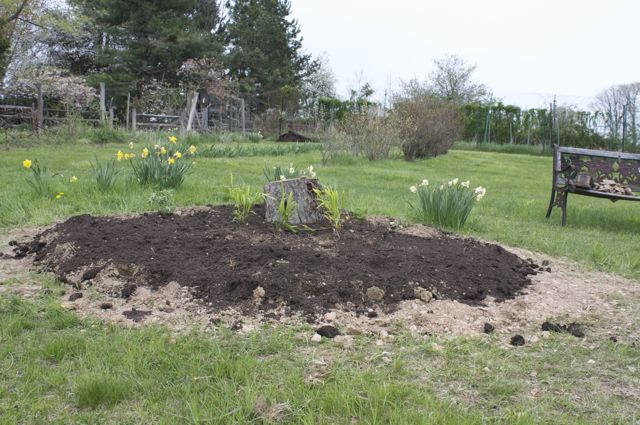
Final result
A Stump is added in lieu of a boulder that should go there some day, but I haven’t found a good one yet.

A home for the Northern Sea Oats (Chasmanthium latifolium)
And that dear reader is how one thing leads to another. The area is big enough that we can already see that it needs a Caryopteris (Blue Mist) on one side and a Potentilla (Gold Drop) on the other. I hear the local nurseries singing their siren song…
Black Gold and Other Valuables
Yesterday I went to the local landfill for a couple of more loads of the double grind mulch that they produce. It’s really cheap for a fine product — $8.50 gets a cubic yard (or the equivalent of 13-14 of those bags that Home Depot and Lowes sell). While I was there I noticed that they now also sell compost for the same price. This is really good looking stuff so I brought some home just in case I had need of this beautiful stuff that gardens are made of…

A pickup truck load of compost is about $10
They have really done an excellent job in producing this material. Here is a picture with my pocketknife for scale.

Details of the compost
Now all we need is someone to spread a little top layer on all the garden beds…
I also couldn’t help reflecting on how beautiful and exotic many of the plants look as the emerge from the earth.

Fritillaria emerging
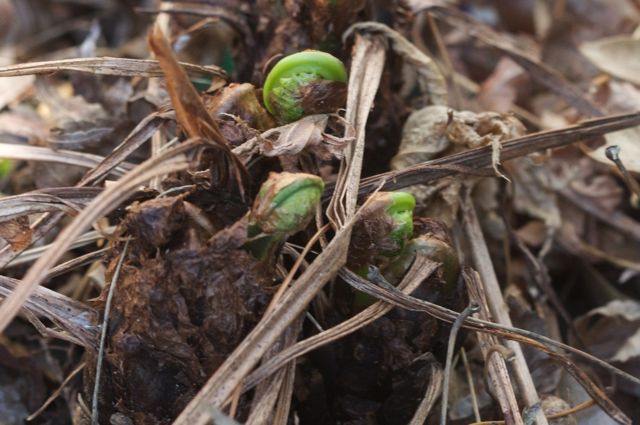
Fiddlehead from Ostrich Ferns emerging

Wood Poppy (Stylophorum diphyllum) Emerging

Established clump of Virginia Bluebells coming out
Caution: New Garden Under Construction
The area behind and to the side of our garage has been a perennial sore spot. At times it has been the place we put the trash, old construction materials, or unused mulch bags. Over time it has accumulated some pernicious weeds (Virginia Creeper, Multiflora Roses, Blackberries, Poison Ivy). At one point we put down landscaping fabric and put mulch on top of it. Eventually the weeds came back but even before that our scheme was foiled by Woodchucks which insisted that the area under the garage is their claimed territory. And when they dug their holes the earth came out on top of the mulch and landscaping material and provided a nursery ground for the weeds.

The Before Picture — Back of the Garage
Nevertheless, as our horticultural pursuits press outward from the yard per se, we aim to give this spot a try again. Yesterday and today I knocked down the standing weeds with my Mattock and then brought in 8 or 9 scoops of topsoil with the front-end loader from the large reserve we have in the pasture. I didn’t take out the landscaping fabric which is already covered with years of mulch and deposited earth. It’s broken in many places but would be a real pain to remove as well. This is an awkward spot to rototill in any case and to plant shrubs we just need to dig a hole where the plants will go. I raked the soil into place and left it to settle in.

New Shrub Garden
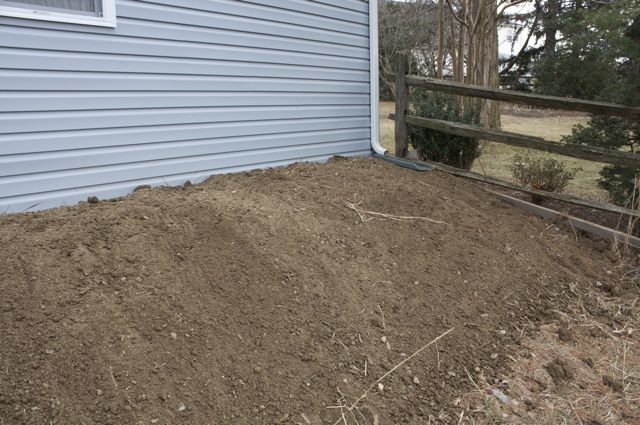
Nice Top Soil
This garden is going to be facing two special challenges (beyond all the normal gardening vicissitudes). First the Groundhog is still there under the garage and he’s already dug his entrance again after I filled it in. I’ve trapped and trapped that family so that they now have a whole extended clan down by the Monocacy River. I’m not sure what else to do. And the weeds haven’t gone away. They are all just under the surface waiting for more of this really pleasant weather to pop up. So the plan is to mulch the hell out of this bank. Our local landfill sells double ground mulch for $8.50 a ton. I picked up two tons (1 ton = 1 pickup load) today and I’ll get more next week.

Delivering the Mulch with my Pickup
So the idea is that somehow we will find some low maintenance, highly attractive shrubs that will dominate over the weeds and yet not be invasive themselves. This is not an easy challenge. The location gets a fair amount of sun but is sort of a sun/shade exposure thanks in part to the neighboring White Pine. So far we’re thinking maybe Hydrangea, Potentilla, Clethra, or Viburnum, mixed in with some substantial grasses. We already have a number of Holly, Nandina, and Pieris in the yard so probably not those even though the Holly would fit our needs very well. Any other ideas?